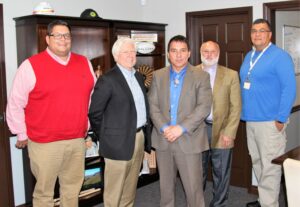By ROBERT JUMPER
ONE FEATHER EDITOR
Efforts to create affordable, mixed-use housing for the Eastern Band of Cherokee Indians (EBCI) continued with a preliminary visioning meeting on Tuesday, April 2 with the company that won the request for qualifications for architectural and engineering services for the Camp Creek Housing Development Master Plan and Design, Shook Kelley based in Charlotte.
In their February 2019 proposal, Terry Shook, one of the principal partners of the firm, said he was challenged by the words of Principal Chief Richard G. Sneed, who attend the RFQ review session and stated, “The project before you represents the single greatest leap in housing for our enrolled members in a very long time.”

Pictured, left to right, are EBCI Housing Secretary Travis Smith, Terry Shook – Shook Kelley, Inc. President, Principal Chief Richard G. Sneed, Frank Quattrocchi with Shook Kelley, and Nathaniel “Bunsey” Crowe with the EBCI Housing Division. (ROBERT JUMPER/One Feather photos)
Shook said that he took from Chief Sneed’s statements that the Eastern Band of Cherokee Indians cared about economic security, nurturing the people and the land. He said, “I heard a deeper, parallel narrative, one that speaks to the core of the Cherokee people, the love of your culture and the land which is so much a part of it.”
In his response, dated Feb. 1, Shook spoke of his company’s commitment to cultural preservation. “At Shook Kelley, we are focused on cultures. Our diverse practice is based upon discovering and understanding how we human beings organize ourselves, create bonds and establish an identity within groups and with the outside world. This foundational understanding greatly informs our planning and architectural practice. Moreover, the value of a Shook Kelley engagement extends beyond the narrow confines of professional planning and design. Because of our focus on cultures-what people value and how they change, we are equally concerned about outcomes. This is, we are not only laser=like in creating a better-built environment, but we are also concerned as to how our insight can be useful in the development, management, and social policies that will create and sustain the new community.”
Shook, president of Shook Kelley, Inc., and Frank Quattrocchi, also a principal partner at the firm, sat with EBCI Housing Secretary Travis Smith and staff to have an initial discussion on what the 188-acre Camp Creek development might look like as a functioning community. The Camp Creek site is also known as the Old Doc Mitchell Farm-place. The property is in Jackson County and is not federal trust land. Secretary Smith said that building on land not directly under federal regulation would provide more options and allow the project to move more quickly.
Shook spoke of his local roots in the Tribe’s neighboring counties. He mentioned ancestral connections to both Macon, Haywood, and Jackson counties. So, he noted he feels a special connection to the area and the Eastern Band.
Secretary Smith explained that, like in other areas, communities do not understand what workforce housing is and look it as exclusionary. He said he wants the community to understand what workforce housing means. “It is not dormitory-style housing. My home is workforce housing. I have to work to pay for it, and I work here to do that.” Workforce housing simply means creating space to accommodate the workforce needed for economic sustainability. The type of housing will vary based on the needs of the businesses and the community.

Shook Kelley President Terry Shook and EBCI Housing Secretary Travis Smith discuss a vision for the Camp Creek project during a meeting on Tuesday, April 2.
He read the Housing Division mission statement to the group. “We will provide all tribal members with a foundation for success in life through the basic right of quality and affordable housing opportunities while promoting self-sufficiency, community revitalization, for long term economic success and sustainable quality of life.” He went on to say that the Tribe is approximately 1,000 units short of the housing need for the current workforce demand.
The Housing Division expressed to the firm that they envision both rental and homeownership in the new community. There will be those who find their long-term career with the Tribe or nearby business, and they will want the opportunity to buy a home while others will only need temporary housing as they transition from one job to the other. Part of the vision for the property is for it to be a sustainable community, complete with amenities like a grocery store.
Shook shared how the company has worked with other municipalities and tribes, including the Pueblo of Santa Ana in California, to create communities. He said they would do a “deep dive” into the Tribe’s culture, history, and people. Shook said that while he had contact and relationship through his time in this area many years ago, he wants to reconnect to get to know the Cherokee people of today.
The meeting continued in Chief Sneed’s office at the end of Tribal Council’s Budget Council session. Chief Sneed echoed his thoughts on the need for a project of this nature. “We recognize that our ability to build on tribal land is greatly diminished. All the easily buildable and easily accessible sites are already built upon. Everything we do now ends up costing a hundred thousand dollars or more to get a driveway and (house site preparation). We can’t keep doing that.”
He added, “This project represents the single greatest opportunity to provide the largest number of dwellings for tribal members in the most cost-effective manner.”
More information on Shook Kelley, Inc. is at www.shookkelley.com.


